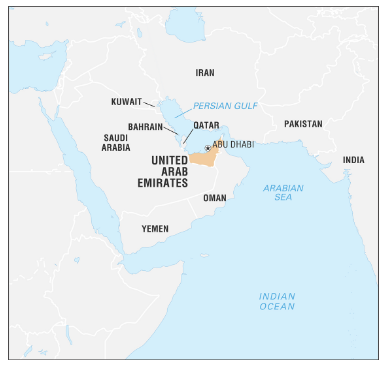Context:
Recently, the Indian Prime Minister was on his fifth visit to the UAE in the last eight years and the Central Bank of India & UAE agreed to establish a framework for enabling the use of local currencies for cross-border transactions.
 Image Credits: Encyclopedia Britannica
Image Credits: Encyclopedia Britannica
About Local Currencies for Cross-Border Transactions:
- Promotion of Local Currencies: A pact was signed to promote the use of rupee and UAE dirham (AED) for cross-border transactions.
- LCSS: Focus was on the establishment of the Local Currency Settlement System (LCSS).
- Example: Enabling exporters and importers to invoice and pay in their domestic currencies, reducing transaction costs and settlement time.
- Significance:
- Use of Domestic Currencies: It would enable exporters and importers to invoice and pay in their respective domestic currencies.
- Exchange Market: It would enable the development of an INR-AED foreign exchange market.
- Promote Investment: It would also promote investments and remittances between the two countries.
- Transaction Cost & Settlement Time: It would optimize transaction costs and settlement time for transactions, including for remittances from Indians residing in the UAE.
- Boost Trade: It would improve the ease of doing business and boost trade.
- Internationalization of Rupee: It could also potentially serve as a precursor for other bilateral currency and further could act as an important first step for the internationalization of the rupee.
Other Key Highlights of the Visit:
- Energy Sector Collaboration: Cooperation in Green Hydrogen, solar energy, and grid connectivity.
- Example: Joint development of renewable energy projects in both countries.
- Strategic Petroleum Reserves: Increased investment in India’s Strategic Petroleum Reserve Programme.
- Example: Recently, India allowed Abu Dhabi National Oil Co (ADNOC) to export oil from its Mangalore strategic petroleum reserve (SPR).
- Climate Change Cooperation: Joint work on climate change during India’s G20 presidency and UAE’s COP28 presidency.
- Commitment to make COP28 a success.
- The COP28 summit will be the first formal assessment of countries’ progress towards the Paris Agreement’s target to limit climate change to 1.5 Celsius (34.7 Fahrenheit) of warming.
- Example: Collaborating on renewable energy initiatives to reduce carbon emissions.
- Indian Diaspora and Bilateral Trade: Facilitating ease of business for Indian companies in the UAE and vice versa.
- India-UAE CEPA: In May 2022, India became the first country with which UAE signed the Comprehensive Economic Partnership Agreement (India-UAE CEPA), which is a kind of free trade pact that covers negotiation on the trade in services and investment, and other areas of economic partnership.
- Food Projects: To promote the reliability and resilience of food supply chains and expand food and agriculture trade, including through food corridors projects in India.
Bilateral Relations:
- Diplomatic Relations:
- Established in 1972.
- Strengthened economic, defense, security, and law enforcement cooperation.
- Example: India and the UAE partnering on defense technology and joint military exercises.
- Economic Relations:
- India-UAE trade rose to USD 85 billion in 2022.
- UAE is India’s third-largest trading partner for 2022-23.
- UAE is India’s second-largest export destination.
- Annual remittances by the Indian community in the UAE over US $17.06 billion.
- Example: India’s export of pharmaceuticals and IT services to the UAE.
- Bilateral trade is currently at USD 85 billion, aiming to reach USD 100 billion.
- Energy Security and Technology Partnerships:
- UAE is a reliable energy exporter for India’s growing industrial and manufacturing capacity.
- Agreements on oil supply and pricing.
- Digital innovation and technology partnerships.
- Example: Collaboration between ISRO and UAESA for space missions.
- Common Stance on International Issues:
- Similar opinions on strategic issues like the dominance of the US dollar in international trade and counterterrorism efforts.
- Advocacy for a rules-based international order.
- Example: Participation in minilateral groupings like India-UAE-France maritime trilateral.
Challenges in the Relations:
- Implementations in Investment: As far as investments are concerned, slow implementation from the Indian side is a major obstacle.
- Trade: Bilateral trade is not appropriate, which potential both the countries have.
- Workers: The workers from other nationalities including Filipinos and Bangladeshis are replacing Indian workers in UAE.
- Balancing geopolitics: India with Iran and UAE with China, resulting in impacts of bilateral relations.
Way Forward:
- Timely Investment: India needs to ensure the execution of the investment projects in specified time with high-quality.
- Medical Tourism: Both India & UAE cooperate further in medical tourism.
- Clean Energy: The Clean Energy Sector is having a very high level of potential for cooperation between the two countries and Indian companies with expertise in the renewable energy sector can invest in UAE.
- Defense: In the defense sector, both the countries can enhance their cooperation through joint training programmes.
News Source: The Hindu
![]() 18 Jul 2023
18 Jul 2023
 Image Credits: Encyclopedia Britannica
Image Credits: Encyclopedia Britannica